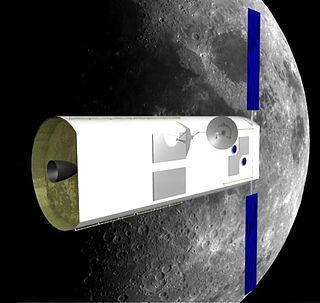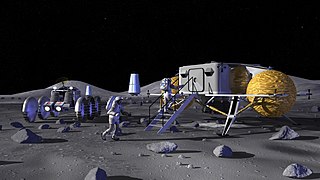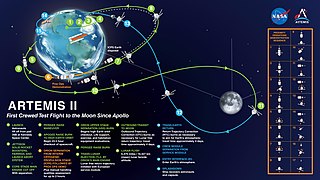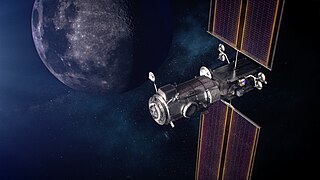Related Research Articles

The Space Shuttle program was the fourth human spaceflight program carried out by the U.S. National Aeronautics and Space Administration (NASA), which accomplished routine transportation for Earth-to-orbit crew and cargo from 1981 to 2011. Its official name, Space Transportation System (STS), was taken from a 1969 plan for a system of reusable spacecraft of which it was the only item funded for development. It flew 135 missions and carried 355 astronauts from 16 countries, many on multiple trips.
Human spaceflight programs have been conducted, started, or planned by multiple countries and companies. The age of manned rocket flight was initiated by Fritz von Opel who piloted the world's first rocket-propelled flight on 30 September 1929. All space flights depend on rocket technology; von Opel was the co-designer and financier of the visionary project. Until the 21st century, human spaceflight programs were sponsored exclusively by governments, through either the military or civilian space agencies. With the launch of the privately funded SpaceShipOne in 2004, a new category of human spaceflight programs – commercial human spaceflight – arrived. By the end of 2022, three countries and one private company (SpaceX) had successfully launched humans to Earth orbit, and two private companies had launched humans on a suborbital trajectory. The criteria for what constitutes human spaceflight vary. The Fédération Aéronautique Internationale defines spaceflight as any flight over 100 kilometers (62 mi). In the United States professional, military, and commercial astronauts who travel above an altitude of 80 kilometers (50 mi) are awarded the United States Astronaut Badge. This article follows the FAI definition of spaceflight.

The Artemis Project was a private spaceflight venture to establish a permanent, self-supporting base on the Moon by 2002. It was named after Artemis, the goddess of the hunt, in some myths the moon, and twin sister of Apollo. The project's creators, the Lunar Resources Company, formed the Artemis Society as a non-profit NGO in 1994. They planned to cover the costs by exploiting the entertainment value in creating a lunar colony. They also believed that their costs would be a small fraction of what a government agency, such as NASA, would have spent.

Stephanie Diana Wilson is an American engineer and a NASA astronaut. She flew to space onboard three Space Shuttle missions, and is the second African American woman to go into space, after Mae Jemison. As of 2022, her 42 days in space are the second most of any female African American astronaut, having been surpassed by Jessica Watkins in 2022.

Gregory Errol Chamitoff is a Canadian-born American engineer and former NASA astronaut. He has been to space twice, spending 6 months aboard the ISS across Expedition 17 and 18 in 2008, and another 15 days as part of STS-134 in 2011. STS-134 was the last of Space Shuttle Endeavour which delivered the Alpha Magnetic Spectrometer and completed the US Orbital Segment.

A moonbase is a facility on or below the surface of the Moon, enabling human activity on the Moon. As such, it is different from a lunar space station in orbit around the Moon, like the planned Lunar Gateway of the Artemis program. Moonbases can be for robotic or human use, in both cases not necessarily including lunar habitation facilities. A base might be a step towards colonization.

The National Aeronautics and Space Administration is an independent agency of the U.S. federal government responsible for the civil space program, aeronautics research, and space research. Established in 1958, NASA succeeding the National Advisory Committee for Aeronautics (NACA), to give the U.S. space development effort a distinctly civilian orientation, emphasizing peaceful applications in space science. NASA has since led most American space exploration, including Project Mercury, Project Gemini, the 1968–1972 Apollo Moon landing missions, the Skylab space station, and the Space Shuttle. NASA currently supports the International Space Station and oversees the development of the Orion spacecraft and the Space Launch System for the crewed lunar Artemis program, the Commercial Crew spacecraft, and the planned Lunar Gateway space station.

Gregory Reid Wiseman is an American astronaut, engineer, and naval aviator. He served as Chief of the Astronaut Office until November 14, 2022.

Victor Jerome Glover is a NASA astronaut of the class of 2013 and Pilot on the first operational flight of the SpaceX Crew Dragon to the International Space Station. Glover is a captain and F/A-18 pilot in the U.S. Navy and is a graduate of the U.S. Air Force Test Pilot School. He was a crew member of Expedition 64, and served as a station systems flight engineer.

Christina Hammock Koch is an American engineer and NASA astronaut of the class of 2013. She received Bachelor of Science degrees in electrical engineering and physics and a Master of Science in electrical engineering at North Carolina State University. She also did advanced study while working at the Goddard Space Flight Center. Just before becoming an astronaut, she served at the National Oceanic and Atmospheric Administration as station chief for American Samoa.

Nicole "Duke" Victoria Aunapu Mann is an American test pilot and NASA astronaut. She is an F/A-18 Hornet pilot, and a graduate of the US Naval Academy, Stanford University and the US Naval Test Pilot School. She has over 2,500 flight hours in 25 types of aircraft and 200 carrier landings, and has flown 47 combat missions in Iraq and Afghanistan. Mann completed astronaut training in 2015 and was assigned in August 2018 to Boe-CFT, the first crewed test flight of the Boeing CST-100 Starliner, but subsequently reassigned to the SpaceX Crew-5, becoming the first female commander of a NASA Commercial Crew Program launch.

Artemis 2 is the second scheduled mission of NASA's Artemis program and the first scheduled crewed mission of NASA's Orion spacecraft, currently planned to be launched by the Space Launch System (SLS) in November 2024. The crewed Orion spacecraft will perform a lunar flyby and return to Earth. Artemis 2 is planned to be the first crewed spacecraft to travel to the Moon, and beyond low Earth orbit, since the Apollo 17 mission in 1972.

Artemis 3 is planned as the first crewed Moon landing mission of the Artemis program and the first crewed flight of the Starship HLS lander. Artemis 3 is planned to be the second crewed Artemis mission and the first crewed lunar landing since Apollo 17 in December 1972. As of 2023, the mission is scheduled for December 2025.

The Lunar Gateway, or simply Gateway, is the first planned extraterrestrial space station. It will be placed in lunar orbit and is intended to serve as a solar-powered communication hub, science laboratory, and short-term habitation module for government-agency astronauts, as well as a holding area for rovers and other robots. It is a multinational collaborative project involving four of the International Space Station partner agencies: NASA, European Space Agency (ESA), Japan Aerospace Exploration Agency (JAXA), and Canadian Space Agency (CSA). It is planned to be both the first space station beyond low Earth orbit and the first space station to orbit the Moon.

The Artemis program is a robotic and human Moon exploration program led by the United States' National Aeronautics and Space Administration (NASA) along with five major partner agencies— the European Space Agency (ESA), the Japan Aerospace Exploration Agency (JAXA), the Canadian Space Agency (CSA), the Israel Space Agency (ISA) and the Australian Space Agency (ASA). The Artemis program is intended to reestablish a human presence on the Moon for the first time since the Apollo 17 mission in 1972. The main parts of the program are the Space Launch System (SLS), the Orion spacecraft, the Lunar Gateway space station, and the commercial Human Landing Systems. The program's long-term goal is to establish a permanent base on the Moon to facilitate the feasibility of human missions to Mars.

CAPSTONE is a lunar orbiter that will test and verify the calculated orbital stability planned for the Lunar Gateway space station. The spacecraft is a 12-unit CubeSat that will also test a navigation system that will measure its position relative to NASA's Lunar Reconnaissance Orbiter (LRO) without relying on ground stations. It was launched on 28 June 2022, arrived in lunar orbit on 14 November 2022, and was scheduled to orbit for six months. On 18 May 2023, it completed its primary mission to orbit in the near-rectilinear halo orbit for six months, but will stay on this orbit, continuing to perform experiments during an enhanced mission phase.
References
- ↑ "Artemis Magazine". The Encyclopedia of Science Fiction. Retrieved 9 August 2023.
- ↑ "The Artemis Project: Selling the Moon". Analog. January 1995 – via The Lunar Resources Company.